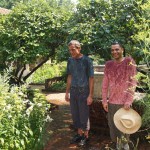Thursday, July 3, 2008

We are out busily soaking the gardens on a very warm day, in anticipation of a long, hot, holiday weekend. We do not have drip watering at The Cloisters, for a number of reasons. They did have drip watering in the Middle Ages. More anon.
???Deirdre Larkin
Tags: watering
This entry was posted
on Thursday, July 3, 2008 at 3:56 pm and is filed under Gardening at The Cloisters.
You can follow any responses to this entry through the RSS 2.0 feed.
Responses are currently closed, but you can trackback from your own site.


July 5, 2008 at 3:17 pm
This is a beautiful picture. You should display more pictures like this showing the men and women who make the cloisters possible. In fact why not publish a book on the mainteance of the Cloisters.
July 7, 2008 at 2:16 pm
We do intend to cover gardening activities and techniques on the blog, as well as botany, ethnobotany,and garden history. The picture, a favorite of mine, was taken by Barbara Bell, a talented artist and photographer who volunteers in the gardens of The Cloisters.
We are planning a book on the gardens, but had not thought about including the gardeners—it’s a good idea.
July 11, 2008 at 4:04 pm
It’s wonderful to have this information available for those interested in the gardens! And if it weren’t for the enthusiasm of your loyal gardener, Ted Pender, many of our friends and family wouldn’t have known about its seasonal beauty. Thank you for posting these updates and photos.
July 12, 2008 at 2:10 pm
This image is wonderful. I notice some berries in the bottom right corner. What are they and why are they grown in this particular garden?
July 14, 2008 at 10:47 am
Julie—
The berries you remarked on are the fruit of woody nightshade (Solanum dulcamara.) The plant is also known as bittersweet, a literal translation of the Latin epithet given to the species. This perennial woody vine is trained on a trellis in a bed devoted to plants used in medieval magic in Bonnefont Herb Garden. You might well be surprised to see it growing in a garden, since it is a common weed in the United States.
The ovoid berries ripen to red in late June or early July. Unlike other members of the nightshade family, whose fruits may be highly poisonous, the ripe berries of bittersweet are mildy toxic. While the poisonous black berries of deadly nightshade had a sinister connotation in the Middle Ages, the red fruits of woody nightshade had a positive significance and were used as a protection against evil.